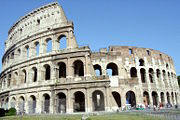


The Colosseum is the finest example of ancient Roman architectural engineering. It is one of the most famous ruins in the world where thousands of tourists visit it every year. Events such as fights between gladiators and between men and wild animals were held there during the Romans Era. The oval-shaped, sand-covered floor of the arena originally could be flooded with spectators. The cages for people and animals were installed beneath the arena. A wall separated the arena from spectators whose seats rested on sloping concrete supports as in many stadiums today.


During the first century, the coliseum was built as a gift to the Roman citizens. In 72 AD, Vespasian started constructing the coliseum in the ground of Emperor Nero’s (37-68AD) private residence. Domus Aurea and his son (Titus) inaugurated it in 80 AD. Inaugural games usually lasted for 100 days and nights, 5,000 animals were slaughtered. The fighters once held 117 games, 9,000 gladiators fought to the death. Most of the fighters were slaves or prisoner and some were volunteers. This is because they wanted to collect the money they got from the games they had wins, so that they could pay for their freedom. During the inaugural games, spectators saw persecuted Christians killed by lions.


After 404 AD, gladiator fights were no longer allowed, but animals such as lions, elephants, snakes, panthers continued to be massacred in the name of sport until 6th century.When the empire fall, the coliseum was abandoned and gradually become overgrown. In the middle ages, stones from the coliseum were removed for new buildings.
The coliseum was over 160 feet high and divided into four floors. There were 80 entrances for the coliseum. It could hold 50,000 spectators at one time. It was used for gladiator fights, mock naval battles and wild animal hunts. A linen awning was used to protect the spectators from the heat of the sun. The spectators were divided into groups, the upper class and the lower class. The upper class sit on the seat made of marble but the lower class sit on the wooden benches.



http://www.teachingtools.com/Slinky/colosseum.html
http://www.mapsofworld.com/travel-destinations/statue-of-christ-the-redeemer.html
Done By: Wali (Wonders crew)